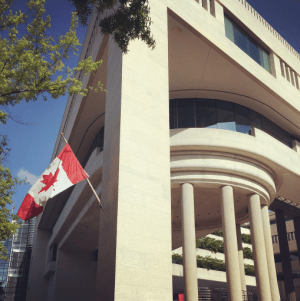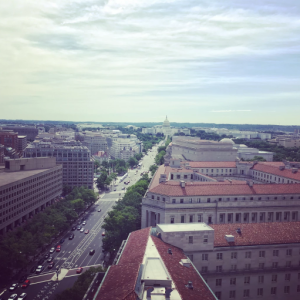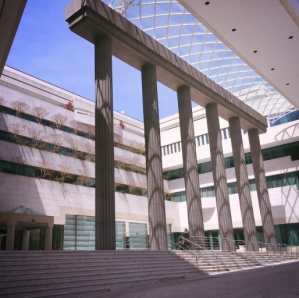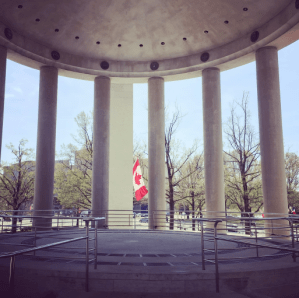#architecture #canada #embassies #Pennsylvaniaavenue #WashingtonDC
Embassy of Canada

Welcome to the inaugural edition of Design Spotlight, a monthly blog post that will delve into the design of Washington’s architectural marvels and best kept secrets! This month, we’ll take a look at the Embassy of Canada.
 The Embassy of Canada is the only diplomatic building along eastern Pennsylvania Avenue, the political heart of Washington DC, but the current home is relatively new. The Canadian Embassy was formerly located on Massachusetts Avenue or “Embassy Row“, in a mansion built by stock broker Clarence Moore in 1918. Sadly, Moore lived in his Washington home for less than three years before perishing in the sinking of the Titanic in 1921. Canada purchased the property from Moore’s widow in 1927, and today the building houses the Embassy of Uzbekistan.
The Embassy of Canada is the only diplomatic building along eastern Pennsylvania Avenue, the political heart of Washington DC, but the current home is relatively new. The Canadian Embassy was formerly located on Massachusetts Avenue or “Embassy Row“, in a mansion built by stock broker Clarence Moore in 1918. Sadly, Moore lived in his Washington home for less than three years before perishing in the sinking of the Titanic in 1921. Canada purchased the property from Moore’s widow in 1927, and today the building houses the Embassy of Uzbekistan.
 Over time, the Canadian delegation outgrew the Moore home on Embassy Row. In 1978, Canada purchased a lot near the Capitol, on the site of a former Ford car dealership, as part of a growing movement to revitalize Pennsylvania Avenue between the US Capitol and the White House. The neighborhood around “America’s Main Street” had long suffered from blight and neglect. Originally known as “Murder Bay”, the south side of Pennsylvania Avenue had been rebuilt as Federal Triangle in the 1930s. During his inaugural parade, President John F. Kennedy was shocked by the contrast between the dilapidated state north of Pennsylvania Avenue and the imposing Federal buildings to the south. The President and First Lady urged Congress and the city to fully revitalize this grand boulevard and the surrounding area.
Over time, the Canadian delegation outgrew the Moore home on Embassy Row. In 1978, Canada purchased a lot near the Capitol, on the site of a former Ford car dealership, as part of a growing movement to revitalize Pennsylvania Avenue between the US Capitol and the White House. The neighborhood around “America’s Main Street” had long suffered from blight and neglect. Originally known as “Murder Bay”, the south side of Pennsylvania Avenue had been rebuilt as Federal Triangle in the 1930s. During his inaugural parade, President John F. Kennedy was shocked by the contrast between the dilapidated state north of Pennsylvania Avenue and the imposing Federal buildings to the south. The President and First Lady urged Congress and the city to fully revitalize this grand boulevard and the surrounding area.
To design the new Canadian Embassy in such a prominent location, then Prime Minister Pierre Trudeau turned to decorated architect Arthur Erickson. Erickson was born in Vancouver, Canada in 1924 and earned his architecture degree at McGill University. In 1963, Erickson, in collaboration with fellow Canadian architect Geoffrey Massey, won a competition to design Simon Fraser University in British Columbia. Erikson then became famous in Canada for his modernistic, concrete post-and-beam designs. Arthur Erickson was awarded the Gold Medal from the American Institute of Architects in 1986, the first Canadian to receive the honor.
 Erikson’s Embassy design is meant to reflect the culture of Canada, while blending with the surrounding government buildings. During design, the Pennsylvania Avenue Development Corporation dictated the boundaries and footprint of the site, which allotted more square footage than the embassy required. Thus, Erikson incorporated a large outdoor courtyard to fill the lot. This open area is bordered by six massive columns supporting a glass canopy, and is accessible to the public on two sides. A rotunda on the southeast corner juts out toward the street. The interior courtyard facade features a cascade of three planted terraces, decorated with Canadian Hawthorn trees and white azaleas.
Erikson’s Embassy design is meant to reflect the culture of Canada, while blending with the surrounding government buildings. During design, the Pennsylvania Avenue Development Corporation dictated the boundaries and footprint of the site, which allotted more square footage than the embassy required. Thus, Erikson incorporated a large outdoor courtyard to fill the lot. This open area is bordered by six massive columns supporting a glass canopy, and is accessible to the public on two sides. A rotunda on the southeast corner juts out toward the street. The interior courtyard facade features a cascade of three planted terraces, decorated with Canadian Hawthorn trees and white azaleas.

The Rotunda of the Provinces and Territories, a circle of twelve smaller columns, faces outward from the plaza toward Pennsylvania Avenue. Each column represents one of Canada’s ten provinces and two territories. The rotunda is popular among passers-by, as the domed roof creates a perfect echo chamber. A waterfall cascades down the outer walls of the rotunda, symbolizing Niagara Falls, the most famous site on the United States – Canada border.
In the corner of the plaza sits the Spirit of Haida Gwaii Black Canoe, sculpted by Canadian artist William Reid. The statue references the aboriginal heritage of the Haida Gwaii, a chain of islands in British Columbia. Haida native people have inhabited the islands for over 13,000 years, and now exercise sovereignty as a Canadian First Nation. The bronze sculpture depicts a large traditional cedar canoe bearing thirteen mythical Haidan characters, including a raven, grizzly bears, beaver, eagle, frog, wolf, and the focal point, the human Shaman. The Raven, a trickster in Haida mythology, holds the steering oar, symbolizing the wild unpredictability of nature. This sculpture was featured on Canada’s $20 bill, and two other versions reside in Vancouver Airport and the Canadian Museum of History.

Learn more about the Canadian Embassy, Pennsylvania Avenue, the transformation from Murder Bay to Federal Triangle, and much more on our White House & Pennsylvania Avenue tour. Hear the fascinating stories of other embassies on our Dupont Circle & Embassy Row tour.
Stay tuned for more monthly design spotlights!
